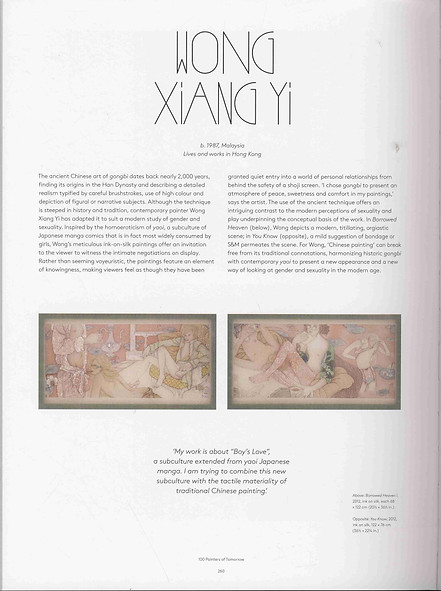媒體露出 Press
一種男男自語-藝術家黃向藝
art plus No.62 / 2016年 12月號 文 / 劉星�佑 圖 / 黃向藝

黃向藝,《無題》,2015 ,絹上膠彩,25.2cm x 18.5cm
女性作為書畫主題,始見六朝顧愷之的《女史箴圖》,經過歷朝歷代的發展,「仕女畫」逐漸成為一種明確獨立的畫種,倘若回顧漫長歷史,有所謂的男性的圖像嗎?在帝王像、高士圖或神仙畫像之中,有男性的形象外,鮮少見到以日常生活中的男性為主題的人物畫,即便斷袖之癖的說法自漢哀帝即有,單以男性為視覺耽美對象的畫作,直到近年有腐女的視角出現,才開始豐富了起來。
藝術之前 旁觀斷袖
所謂的腐女視角,不是在「藝術」作品出現之後才開始有的,藝術家黃向藝受到日本次文化的「薰陶」與「浸淫」,如同在該自述中說到,國中時期,因為著迷於日本漫畫家藤崎龍的作品《封神演義》,在收藏週邊產品的狀況下,買到了《封神演義》的同人誌,撞進了BL的世界,往後的作品中便開始出現了一種男男自語的浪漫異想。有別於BL影音媒體的接受,對於BL漫畫與小說的偏好,充分讓腦補的能力有發揮的空間,圖文的平面性朝向繪畫性的平面,除了腐女視角才能找得到男男之間,互相的曖昧外,藝術家更試圖旁觀自己本身所擁有的腐女視角,讓這樣的BL「雷達」可以被展示與溝通。
隱晦曖昧 低調暴露
黃向藝透過友人反應,才意識到在香港,其實是很少人「大方」的讓他人知道自己具有的腐女特質,然而即使在這樣的社會氛圍下,卻也很清楚的理解,自己以水墨作為創作媒材的必要性為何,就畫類而言,人物畫傳統非常值得回溯與挖掘,這是一個在唐朝之後就由盛轉衰的畫類,也因此在題材的鏈接上,開發屬於女性的「春宮畫」亦是一種可能性,這是不同於以「性」做為觀看愉悅對象的「春宮畫」,而是以「找出曖昧」為成就感的新畫種,燙衣板上趴臥的裸身男子、鏡前佇立宛若自戀的男子,領帶、繃帶、電線等與羈絆相關聯的寓意,從隱晦禁語到含情脈脈,不是遮遮掩掩情慾,而是低調卻無所不用其極的暴露,黃向藝作品在語境多元且開放的今日,有著新的探索方式。而畫面氣氛之於材質之間的關係,暈染的墨韻之於虛無縹緲的不只是效果,更指涉著一種關乎情感與欲望的流變;不可否認的,這既是藝術家特有,也專屬於女性心理表現的繪畫。

黃向藝,《有人在嗎 有誰來找》,2011 ,紙本設色,60cm x 97cm , 60cm x 67cm
Wong Xiang Yi (黃向藝)
100 Painters of Tomorrow (百⼤明⽇畫家) 2014年 出版 / Thames & Hudson 作者 / Kurt Beers

The ancient Chinese art of gongbi dates back nearly 2,000 years, finding its origins in the Han Dynasty and describing a detailed realism typified by careful brushstrokes, use of high colour and depiction of figural or narrative subjects. Although the technique is steeped in history and tradition, contemporary painter Wong Xiang Yi has adapted it to suit a modern study of gender and sexuality. Inspired by the homoeroticism of yaoi, a subculture of Japanese manga comics that is in fact most widely consumed by girls, Wong’s meticulous ink-on-silk paintings offer an invitation to the viewer to witness the intimate negotiations on display. Rather than seeming voyeuristic, the paintings feature an element of knowingness, making viewers feel as though they have been granted quiet entry into a world of personal relationships from behind the safety of a shoji screen. ‘I chose gongbi to present an atmosphere of peace, sweetness and comfort in my paintings,’ says the artist. The use of the ancient technique offers and intriguing contrast to the modern perceptions of sexuality and play underpinning the conceptual basis of the work. In Borrowed Heaven (below), Wong depicts a modern, titillating, orgiastic scene; in You Know (opposite), a mild suggestion of bondage or S&M permeates the scene. For Wong, ‘Chinese painting’ can break free from its traditional connotations, harmonizing historic gongbi with contemporary yaoi to present a new appearance and a new way of looking at gender and sexuality in the modern age.
‘My work is about “Boy’s Love”,
a subculture extended from yaoi Japanese manga. I am trying to combine this new subculture with the tactile materiality of traditional Chinese painting.’


